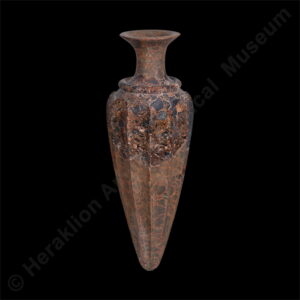
Rhyta are vessels with a pouring hole for the liquid contents. From a practical point of view, rhyta could be used for decanting or filtering liquids, or as libation vessels in ceremonial events, as we see in scenes of Minoan iconography. Clay rhyta appear in a wide range of shapes (conical, ovoid, piriform, cup-shaped), while animal or human rhyta form a distinct category. Rhyta were also made of other, often valuable materials such as metal, stone and ostrich eggs. These luxury vessels were mainly used in special ceremonies in the palatial centres of Minoan Crete, as the excavation context shows. Triton shells, often bearing traces of red paint, were probably used both as rhyta and as ritual musical instruments. Stone rhyta were particularly difficult to make from a technical standpoint. Some, like the Harvester Vase from Agia Triada, were carved with complex scenes, while others were assembled from a variety of precious materials, like the emblematic bull’s-head rhyton from Knossos. In a particularly interesting development, imported Egyptian stone vases were transformed into Minoan-style rhyta by drilling a hole in the base. In the Mycenaean period, rhyta incorporating relief human figures or in the shape of human heads appear. Various types of rhyton also appear in the iconography, the most typical example being the Cup-bearer Fresco from Knossos, depicting a man carrying a large conical rhyton, probably made of gilded silver.